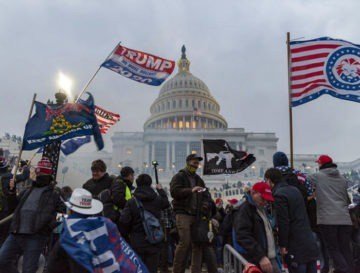Rafia Zakaria in The Baffler:
 At noon, one hour before the two chambers met in joint session, President Trump took the stage before a crowd not far from 1600 Pennsylvania Avenue. There he whipped up the faithful, men and women he had fed and fattened with stories of election fraud and voting dumps, to march on the Capitol and protest outside. The crowd cheered him on, considering themselves to be real (and armed) patriots there to save America at the “Save America rally.”
At noon, one hour before the two chambers met in joint session, President Trump took the stage before a crowd not far from 1600 Pennsylvania Avenue. There he whipped up the faithful, men and women he had fed and fattened with stories of election fraud and voting dumps, to march on the Capitol and protest outside. The crowd cheered him on, considering themselves to be real (and armed) patriots there to save America at the “Save America rally.”
Everyone knows what happened next. Even as cable news switched between the House and the Senate, which had returned to their respective chambers to debate the objections to Arizona’s electoral votes, the crowd outside the Capitol grew and became ever more strident. As the objectors to the electoral vote count began to speak of feigned irregularities, the pulsating crowd laid siege to the Capitol. Then it was up the steps, and ultimately it stormed its way in. Photographs showed Confederate flag-bearing protesters in Statuary Hall, others standing in the Senate Chamber. Who could say whether some were carrying weapons? A photo later showed a man carrying plastic handcuffs, as if he hoped to take hostages.
It was eight o’clock in the evening—two hours after a 6 p.m. curfew came into effect on the streets of D.C. and after law enforcement had “retaken” the Capitol building—when the lawmakers met again. The people were the same, but the political calculations had unalterably changed. Sticking with a post-loss Trump, a move glibly rebranded by Senator Ted Cruz as “[protecting] the integrity of our democratic system,” now bore a greater political cost. Many Americans may have passively supported Trump’s efforts to own the libs and even to complain about fraud; few would be able to applaud the sight of armed protesters storming the Capitol, forcing lawmakers into lockdown and prompting foreign government officials to offer up best wishes for a return to order.
Arguably, it was the only way Trumpism could have been dealt a death blow.
More here.
